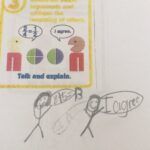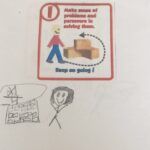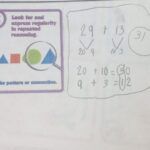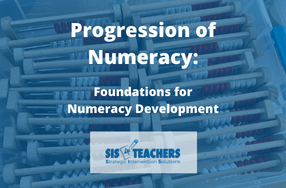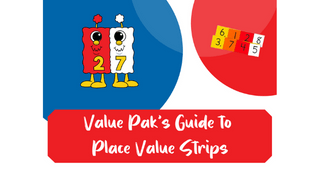
My daughter Emma (7th grade) has done pretty well in math so far. She’s an average student, gives decent effort, and gets really great grades (she’s actually in the National Junior Honor Society!). As Emma moved through elementary school, many of the things I talk about in my presentations, like using the eight mathematical practice standards, number talks, model drawings, all things that are designed to help kids access curriculum, weren’t included in her classroom anymore. Though it wasn’t my favorite thing to do (ask any teacher who has taught all day and then has to repeat lessons for your personal kids), but whenever Emma struggled in math, I could help her at home. Because of what I do, I have access to a whole warehouse full of manipulatives that I often brought out for her, like an abacus or anything she needed when she didn’t understand concepts.
This year, however, when she started middle school, her syllabus for math included things like number talks and 3 Act Math Tasks in their classroom. I was a little shocked…Is this actually really happening?? But I was also excited that Emma would be able to experience and benefit from some of the same strategies and things we (SIS 4 Teachers) do in our project schools. For example, Emma told me about beginning number talks with easy (in my opinion) subtraction problems that her teacher said were to help them develop communicative reasoning and number sense.
The Eight Math Practices in Action
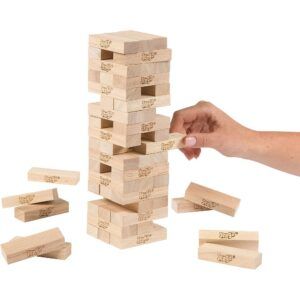 Also early on in the school year, Emma told me about an activity they did in the classroom with the game Jenga. When I questioned the use of the game, Emma said they were playing the game and talking about these math strategies that the teacher told her about. They were each assigned a math strategy, and she got strategy #4. I asked her if that was model with mathematics. She thought it was really weird that I would know that! “Emma,” I said, “we have tons of posters down in our basement with those strategies on them, and everything I do is surrounding the eight mathematical practices.” It was a lightbulb moment for her!
Also early on in the school year, Emma told me about an activity they did in the classroom with the game Jenga. When I questioned the use of the game, Emma said they were playing the game and talking about these math strategies that the teacher told her about. They were each assigned a math strategy, and she got strategy #4. I asked her if that was model with mathematics. She thought it was really weird that I would know that! “Emma,” I said, “we have tons of posters down in our basement with those strategies on them, and everything I do is surrounding the eight mathematical practices.” It was a lightbulb moment for her!
Emma told me that, as each person pushed a piece of the Jenga blocks out, they had to relate it to how they were using their assigned math practice to help execute the game. For modeling with mathematics, Emma had to look at how many Jenga blocks may have been in the way, or how the pattern of the blocks was set up for her to figure out how her movement was going to work and what angle she would go with to model with mathematics.
Applying the Practices
I started thinking about the eight mathematical practice standards that Emma’s teacher was so purposefully involving her students in. They are designed as process standards to help us take the kids deeper into their own understanding of mathematical content. Unfortunately, our SIS consultants tend to report that most teachers are the ones owning these strategies in the classroom. I believe that most students in our schools aren’t challenged enough to bring their understanding of math through the eight mathematical practice standards in order to show how they know what they know. So, how do we get to a point where the students own the eight mathematical practices? Where they are able to do an activity or task and understand which practices they are using?
Sometimes, I hear teachers that say “I taught that practice!” because it says SMP #4 or SMP #6 in the sidebar of their teacher guide. The thing about the eight math practices is that that they are not for us to teach. Any time we teach the content, our students should be going through the eight math practices with that content. When we’re planning, we need to ask ourselves the critical question:
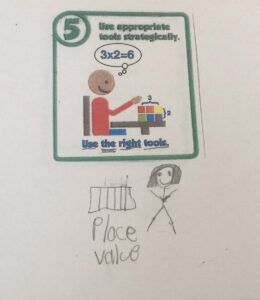
how many opportunities am I creating in this math lesson for students to access the eight mathematical practices?
For example, we could say, “We’re going to be using the abacus in this lesson, which is a tool, so therefore we are using math practice #5.” In fact, that’s not really what that practice is all about. Math practice #5 actually has students “using appropriate tools strategically” to help them draw upon the conclusions that they’re making and what they’re doing in math.
Designing Opportunities
So, what are some ways that teachers can help students to really own the eight math practices?
- Posters. In Emma’s classroom, the teacher created a poster on each math practice based on the experience the students had with playing Jenga and their understanding of how they would be use that practice going forward. Emma was able to explain to me when she would use math practice #4 and how she would use it with different things, whether it would be draw a picture or she might access a tool of some sort or a way that she could explain her thinking in math that would allow her to show how she’s using that practice. These are kind of posters are a great way to start off the school year. To not just have the eight math practices hanging on the wall where we don’t really do anything with them, but how do you interact?
- Booklet. One of our consultants was in Standish-Sterling at one of the elementary schools and had taken some pictures of an idea that a teacher who has gone through our training and is really understanding the eight math practices. In order to help her students understand them, she took the poster from Wayne RESA (linked here) cut it up, and created booklets for the students so they can add information to the appropriate page as they start to introduce the new math practices, they can start to add details to that page in the booklet.
 or example, in math practice #7 kids are expected to look for and make use of structures. In their booklet, they could talk about the Counting Buddy, or the ten-frame mats, or an abacus and when they used place value discs for creating a structure that helps them understanding math in a conceptual way. When students are learning math practice eight, they can jot in things like the associative property and the commutative property. This math practice is all about regularity and repeated reasoning, which is what SMP #8 states. We look for those things within an algorithm. How do we relate what we know about math to other things?
or example, in math practice #7 kids are expected to look for and make use of structures. In their booklet, they could talk about the Counting Buddy, or the ten-frame mats, or an abacus and when they used place value discs for creating a structure that helps them understanding math in a conceptual way. When students are learning math practice eight, they can jot in things like the associative property and the commutative property. This math practice is all about regularity and repeated reasoning, which is what SMP #8 states. We look for those things within an algorithm. How do we relate what we know about math to other things? - Number Talks. Kids can relate to this by number talks, and mathematical practice #3 (construct viable arguments and critique the reasoning of others). Being able to say to another child, “I politely disagree with your answer. I solved it this way,” really shows that the child is using math practice #3 in an appropriate way, which is to be able to construct a viable argument, but not only that, but to be able to critique someone else’s reasoning. I think that’s important too.
- Three Acts Math Tasks. These are really great inquiry-based experiences where you would not only have that experience of going through the Three Act Tasks, but getting the students to reply to which of the math practices they were using. All of the resources that we have for performance tasks on our Free Resources page can help with creating opportunities where you give kids a task that might be more difficult and they have to figure out which math practices they need. It’s not necessarily if they have it right or wrong in the Three Acts Task or performance task, it’s about the journey of how you got there.
- Open-ended Problems. Giving a task where there might not be a definite solution and students have to say why they think it might be a certain way. Again, we want kids to think about what they’re having to do in order to work through to a solution and be able to communicate their reasoning for the solution they found.
- Strategy Games. As kids play some of their favorite math strategy games, such as the ones included in our Math Strategy Games download, or Bump or 9 Holes or Rotten Apples, they are using seven out of the eight mathematical practices! Ask them which practice they were using when they were playing that game. Were they using more than on practice? How were they using that practice to help them in that game be more competitive with their partner?
- Stacking Cups. This game is a task that connects to the eight math practices to build awareness within the students that they’re using them. In this game you might have to communicate, or construct a valid argument that you don’t want that cup stacked there or think about the string and how the rubber band is on the cup.
Transferring Ownership
Our whole goal here is to get kids to take ownership of the eight math practices. How do we help the 21st century student access a higher level of thinking? So many things in a child’s life today involve instant gratification. Students are growing up to be very entitled, which has nothing to do with economic status. Their sense of entitlement comes from everything being so immediately accessible. If they want to know something, they don’t need to research, they just ask Siri or Alexa. They aren’t used to working for it.
 Ultimately, we need to figure out how to make the eight math practices applicable and relevant in our classroom to what we’re teaching, but also to experiences students are having on a daily basis. And it might not just be in math! We actually go through the eight math practices on a daily basis as adults, doing things like getting to work on time or making dinner, or planning a holiday event. Maybe you’re starting a holiday food drive and you’re trying to figure out the space you need for collecting the cans, or how many bags you need to transport the cans to the food bank. We want to get the students themselves to be aware of these practices and say, “I understand that practice and I’m utilizing it this way.”
Ultimately, we need to figure out how to make the eight math practices applicable and relevant in our classroom to what we’re teaching, but also to experiences students are having on a daily basis. And it might not just be in math! We actually go through the eight math practices on a daily basis as adults, doing things like getting to work on time or making dinner, or planning a holiday event. Maybe you’re starting a holiday food drive and you’re trying to figure out the space you need for collecting the cans, or how many bags you need to transport the cans to the food bank. We want to get the students themselves to be aware of these practices and say, “I understand that practice and I’m utilizing it this way.”
It’s really important that staff and teachers have a deep understanding of the eight math practices in order to set up opportunities for students to go through them. If you’d like like to refresh your memory, we have a free recorded webinar from a few years back that you can watch! You can also access think to that webinar and any of our other resources on the math practices on our Free Resources page – click on 8 SMPs tab.
When planning, we want to ask, “Is this rote math to help students regurgitate concepts they don’t understand? Or am I really taking time to dig a mile deep with concepts so that kids can internalize and own what they’re doing?” If we could give students more opportunities to own the eight mathematical practices, I feel like we would teach less because, instead of teachers being the givers of all the information, kids would start to understand things more on their own through inquiry based learning.

